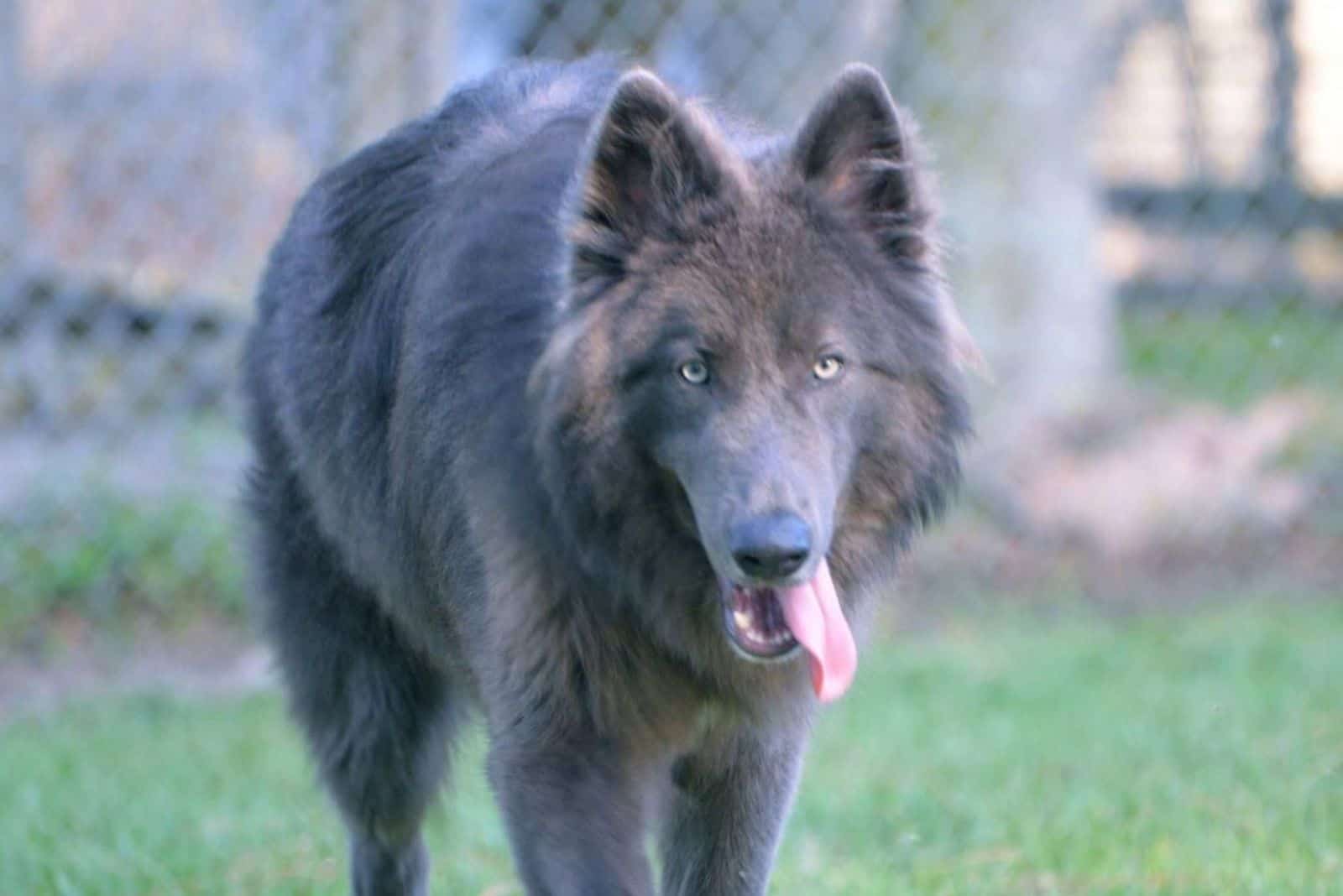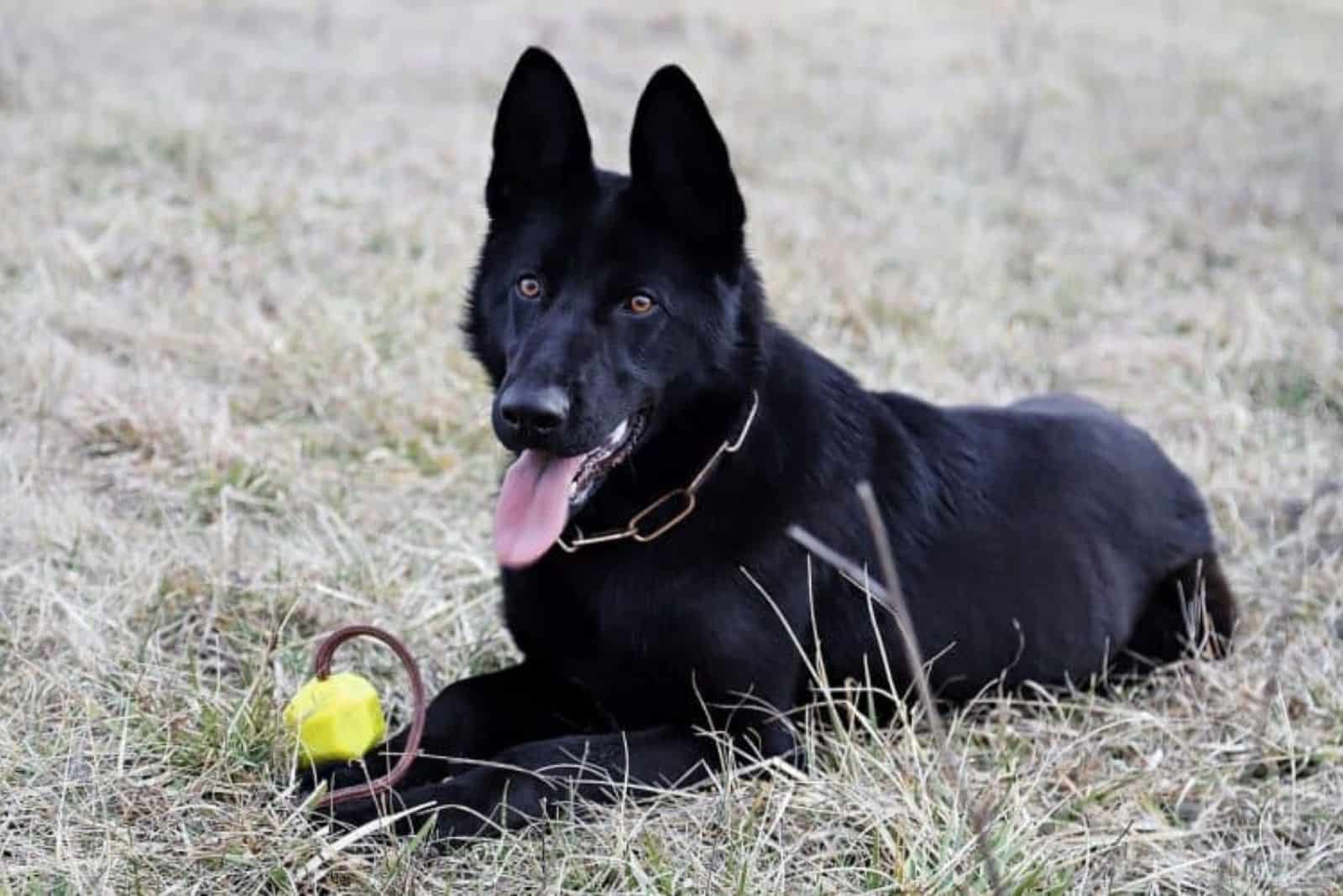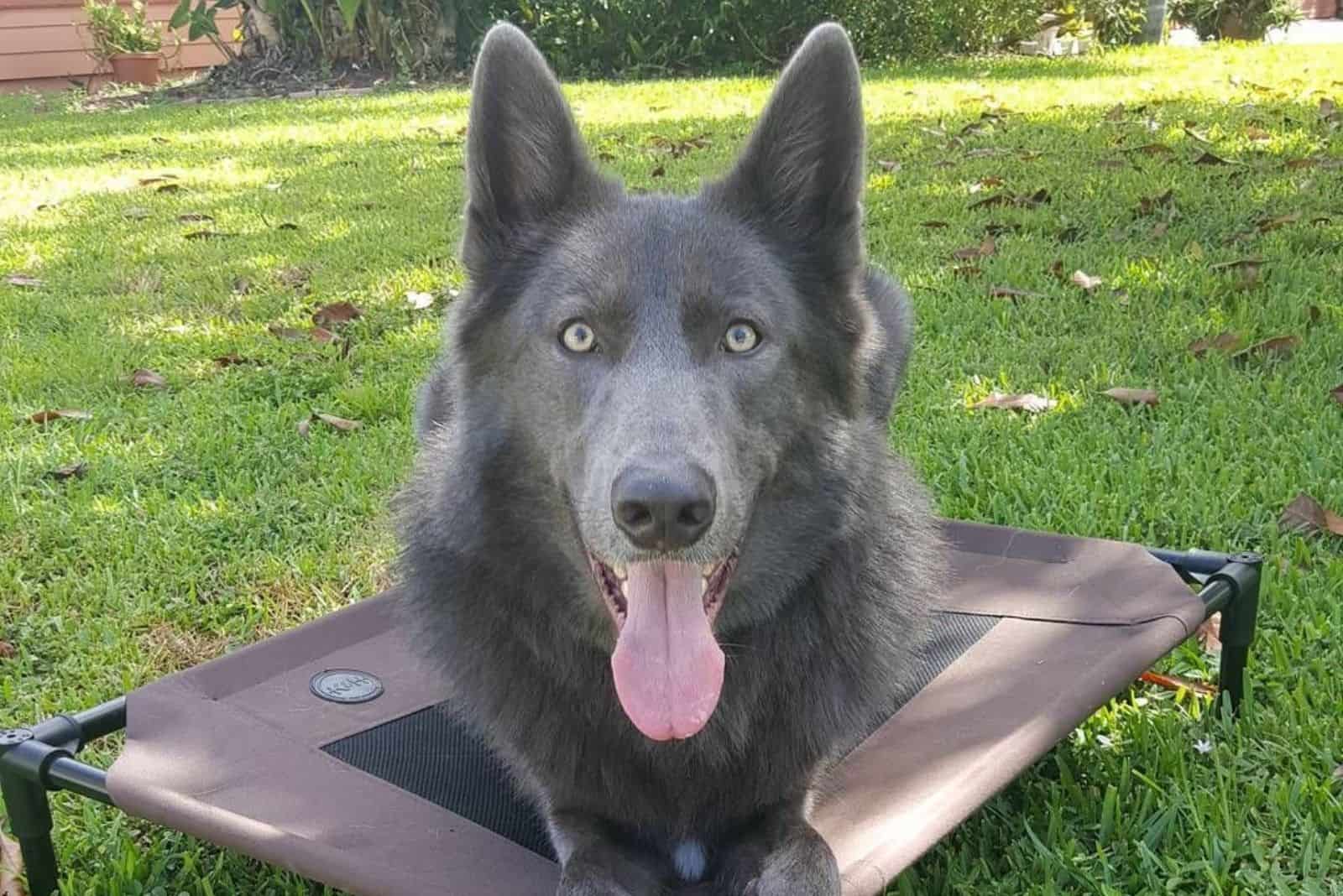Humans have been breeding dogs for hundreds of years, creating a hugely diverse range of dog breeds of all shapes, sizes, and characters.
Some breeds are more popular than others, though fashions tend to change over time, influenced either by celebrities on social media and television or simply through cultural trends.
Once in a while, a new breed emerges that catches our attention because of its striking appearance and exceptional character traits, which is precisely the case with the Blue Bay Shepherd.
It’s so new that there’s a good chance that you haven’t heard of it, or you don’t know much about the breed.
We’re going to remedy this by giving you everything you need to know about this stunningly-beautiful wolf hybrid.
How Old Is This Breed?

It all started around ten years ago at the Southern Breeze Kennels in Florida, where breeder Vicki Spencer had been attempting to create a particular type of dog.
Her quest involved mixing different breeds to find one that embodied all the great physical qualities of wolves, without the negative connections attached to some wolfdog breeds.
Vicki’s experiments proved successful, with the first litter of Blue Bays arriving in March 2011 being a cross between European German Shepherds and blue-coated wolfdogs.
A few other genes were thrown into the mix (rumors claim that up to eight breeds were involved), but Vicki has not revealed the precise genetic makeup.
However, owners who have had their pups tested privately state that both Alaskan Malamutes and Siberian Huskies have contributed to the end result.
Even though several working dogs were part of the process, the aim was to produce a dog that made an ideal family pet.
It had to look wolf-like but be gentle, the sort of dog that wouldn’t be dumped in a shelter because the owners couldn’t handle their temperament!
And if you were wondering about the name, well, the first part is obviously taken from the blue coat, and ‘shepherd’ refers to its German Shepherd parents.
The middle word, bay, comes from the place where the Southern Breeze Ranch is situated: Palm Bay, Florida.
Read Also: Blue Bay Shepherd Breeders: The One And Only
What Do Blue Bay Shepherds Look Like?
To start with, they’re not actually blue. They are more of a slate gray color, but to our eyes, it definitely has a bluish-tinge to it!
This is just one of the traits that Vicki Spencer was determined to achieve in her quest, selecting blue German Shepherds for the task.
To match the blue coat, this breed has beautiful light blue eyes (occasionally brown), giving them a stunning overall appearance.
This coat can be either long or plush (a special name used to describe a medium-short length). The color is more prominent in younger dogs and will settle and fade in later life.
They have upright, triangular ears that are perfectly proportionate to the rest of their body and a lovely straight back.
There is no doubt that the Blue Bay Shepherd is a large breed. Variations in size are common because it is still a new breed, but so far, the facts show that they can reach up to 30 inches (72cm) at the shoulder.
As for their weight, females range from 70lbs (31.75kg) up to 100lbs (45.35kg), and males from 85lbs (38.5kg) to as much as 130lbs (58.96kg)!
What About Their Temperament?

A common misconception persists that large dogs are aggressive. Big dogs can be intimidating purely because of their size, and some working dogs have been bred specifically for their aggression.
And with its wolf ancestry, you could be forgiven for thinking that the Blue Bay Shepherd is a breed to be wary of.
However, nothing could be further from the truth.
This dog has been expertly crafted to have a stable temperament, and by all accounts, is as friendly a dog as you’d wish to meet.
They absolutely love human company and have been specifically bred to be affectionate and highly-trainable. Vicki Spencer has been keen to stress that this trait was even more important to her than the physical qualities.
Don’t be fooled into thinking that they’ll be a pushover, though. Although the ‘guarding instinct’ has been bred out of them, they are not timid and will display protective behavior when the necessity arises.
Another trait that shines through is their intelligence. While this is a good feature, making them attentive and eager to learn as you train them, it could backfire spectacularly should you not keep them stimulated or provide them with plenty of exercise.
Bored and frustrated dogs can misbehave. Add high intelligence, powerful jaws, and large size into the mix, and you have a recipe for disaster.
They’ll chomp their way through your home and find ingenious ways of escaping, as they’re pretty adept at working out how to open latches and doors!
They Need A Lot Of Exercise, Right?

Yes, a lot! Because of their size, they will require a couple of hours of exercise every day.
However, a Blue Bay Shepherd puppy should never be given too much exercise as their joints take a while to become fully formed. If you overdo their exercise at a young age, you run the risk of damaging their joints.
Once they are fully grown, they will need outdoor exercise every day, and they make ideal jogging, running, or hiking partners as they’ll easily keep pace with you.
Though they have their ‘couch potato’ moments, this is not a dog that will be content to lounge about the house all day. Aside from a long walk or run, they’ll still happily dash about the yard or play fetch until they (or, more likely, you!) have had enough.
You’ll need to have a large enough space for them to run and play (or even swim!) as they will not be happy being restricted.
This is an essential point to keep in mind when considering buying a Blue Bay Shepherd.
Do They Have Any Health Issues?

As it is such a new breed, any long-term health problems are still unclear, although potential issues can be determined by examining the health problems faced by the parent breeds.
So far, the following problems have been suggested:
• Bloat – Also called gastric dilatation-volvulus, this is a potentially fatal condition, usually brought on by intensive exercise soon after eating or eating too much too quickly. The stomach starts to twist (filled with gasses or food) and causes a blockage that can damage internal organs or stop blood from flowing to the heart.
• Elbow/Hip dysplasia – A common enough condition, mainly in larger dogs due to their late maturity. The affected joint is malformed, causing pain and discomfort, possibly leading to arthritis in later life.
• Inbreeding depression – This is a result of the line-breeding process (breeding related dogs) and is not related to mental health, as would be natural to assume. Basically, the reduced gene pool has a negative effect on the biological fitness of the subjects, resulting in a greater chance of health issues and reduced herd immunity.
• Allergies – Reports have indicated that quite a few Blue Bays suffer from allergies, which isn’t too much of a surprise. It’s always a good idea to get these checked out, although these aren’t usually severe.
With regards to the hip dysplasia problem, this was one area that Vicki Spencer had hoped to bypass through her breeding program.
Similar attempts have been made with other breeds, such as the Shiloh Shepherd, where breeders aimed to eliminate the dysplasia issue, but so far, the results show that this has failed.
Only time will tell if Vicki has been successful in this area as it’s still too early to say, although the signs seem to be positive so far.
Remember to book regular check-ups with a veterinarian just to be on the safe side.
Do They Need A Lot Of Care?
In a word, yes! Despite their rugged looks, you will need to brush that coat fairly regularly to keep it free of dirt and matting. This will also distribute the natural oils that help to maintain the coat.
Check their ears and eyes as well, as these are places where infection can appear if not kept clean.
Bathing a large dog can be a bit of a trial. If you need help with this, there’s sure to be a local professional groomer who can do the job for you.
Large Dog, Large Appetite?
You bet. Dogs in excess of 100lbs (around 45kg) will consume at least 5 cups of food per day!
In addition, you can’t feed them anything cheap or low-quality, as some of these dogs have pretty sensitive tummies. This means you’ll have to buy premium quality food with few ingredients that isn’t packed with grains.
Ignoring the fact this will not only impact their health but could also leave you with the unpleasant aftermath of a big dog with an upset stomach.
Weighing Up The Pros And Cons

This is one beautiful-looking dog. The silvery-slate color fur is striking, especially when set against those light eyes.
Having looked at some of the facts, we’ll set out the negative and positive points to help you understand the breed better, just in case you were thinking of getting one for yourself:
Positives
• They are super-friendly, affectionate ‘goofballs’ that love to play.
• They look fantastic with their lupine appearance.
• They don’t have the ‘bad reputation’ of wolfdogs.
• They are very easy to train because of their intelligence.
• They make excellent companions, especially for adventurous, outdoor types.
• They are safe with children (early training and socialization are essential, and it is always sensible to supervise any contact with dogs and very young children, as well as educating kids on how to behave around dogs of any breed).
Negatives
• They are pretty expensive to buy and care for.
• They eat a lot! Expect to spend a lot of money on good quality food, especially kibble.
• They are active, energetic dogs that need at least an hour or two outdoor exercise every day.
• They are BIG! If you don’t have much space indoors or have a small yard, then this isn’t going to work out.
• They can be destructive if not given enough exercise or stimulation.
• Not exactly a negative, as such, but some states have very strict laws on wolf hybrids, so be sure that you check them in case you fall foul of the law.
• Again, possibly only a negative for some people: at the moment, American Blue Bay Shepherds are only available from the Southern Breeze Kennels in Florida. Each pup has an official registration number, which is great for limiting chances that you’ve been sold a ‘fake.’

Photo from: @1st508th_airborne
In conclusion, the American Blue Bay Shepherd is a dog for someone who has lots of space at home, indoors and out, preferably with secure, high fences.
They’ll need to be with someone who loves the outdoor life, who enjoys a good hike through the hills and woods.
They’ll need someone who has the income to invest in looking after this handsome, wolf-like dog, as well as the time to invest in their training, exercise, and care.
It won’t be a problem if they have kids or other pets as housemates, so long as the puppy is trained and socialized early, which is common practice with most intelligent breeds.
In spite of its lupine appearance, it is sweet in nature and rarely shows aggression.
Chances are, when you’re walking this beauty, you’ll be stopped every few yards by astonished dog-lovers asking you all about them, as that’s what a lot of owners have found.
It’s still relatively new as a breed, not yet accepted by any kennel clubs, including the American Kennel Club (AKC), but that is something that the breeders hope to change in time.
Awareness of the breed is changing, especially as some of these dogs have their own Facebook pages and YouTube channels!
They’ve even featured on TV, on shows such as Animal Watch, which gave them a real boost.
It’s easy to see why people fall in love with them.
After all, who wouldn’t want a cuddly blue wolf?
Read Next: 31 Wolf Like Dog Breeds: Finest Collection Of Fierce Dogs

















